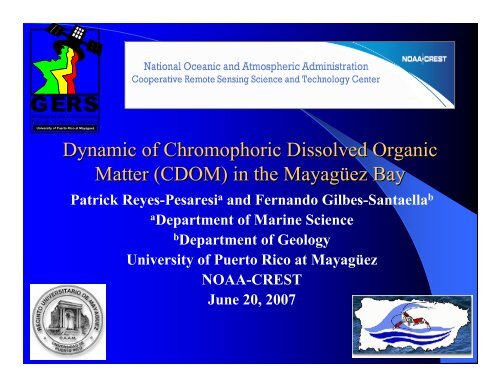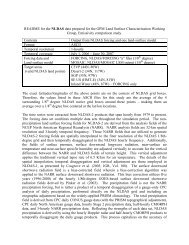Dynamic of Chromophoric Dissolved Organic Matter (CDOM ... - CICS
Dynamic of Chromophoric Dissolved Organic Matter (CDOM ... - CICS
Dynamic of Chromophoric Dissolved Organic Matter (CDOM ... - CICS
- No tags were found...
You also want an ePaper? Increase the reach of your titles
YUMPU automatically turns print PDFs into web optimized ePapers that Google loves.
Components that absorb visible lightin the aquatic environmenta(λ) = a w (λ) +a d (λ) + a ph (λ) + a g (λ)Where:a(λ) = total absorptiona w (λ) = water absorption (Pope & Fry, 2001)a d (λ) = detritus absorption (measured)a ph (λ) = phytoplankton absorption (measured)a g (λ) = <strong>CDOM</strong> absorption (measured)
Then, what is this <strong>Chromophoric</strong> <strong>Dissolved</strong><strong>Organic</strong> <strong>Matter</strong> (<strong>CDOM</strong>)?It is an operational definition:They are all the dissolved organicsubstances in a water sample filtered by0.45-μm that absorb UV-Visible light<strong>CDOM</strong> is mainly compose <strong>of</strong> Humic andFulvic acids
Importance <strong>of</strong> the study <strong>of</strong> the <strong>CDOM</strong> inthe Marine Environment?1- <strong>CDOM</strong> absorbs light in the UV-Visible range:a-Affects the estimate <strong>of</strong> chlorophyll-a concentration by RemoteSensing specially in coastal zonesb-Affects the primary production by light absorptionc-It has been related to the production <strong>of</strong> H 2 O 2 , free radicals andoxidation state <strong>of</strong> metals2- Can have implications in the availability <strong>of</strong> micro andmacronutrients for phytoplankton3- It compose a large fraction <strong>of</strong> the <strong>Dissolved</strong> <strong>Organic</strong><strong>Matter</strong> DOM (40-60%) with the advantage that it canbe studied by Remote Sensing Techniques
Absorption Coefficient Spectrum <strong>of</strong> <strong>CDOM</strong> and<strong>of</strong> Chlorophyll-a Percent <strong>of</strong> Absorption6Absorption Coefficient ( m- 1)543210250 350 450 550 650Wavelength (nm)
Specific ObjectivesDetermine the contribution <strong>of</strong> the <strong>CDOM</strong> to the Bioopticalproperties <strong>of</strong> the Mayagüez Bay from inshore to<strong>of</strong>fshore stations during the rainy and dry seasonsHow is the terrestrially derived <strong>CDOM</strong> transported bythe local rivers diluted and photodegraded from aninshore-<strong>of</strong>fshore gradient?What is the effects <strong>of</strong> the co-transported clay materialin river waters have on the <strong>CDOM</strong> when bothmaterials enter the marine environment?
Study AreaInshore stations:A1AAA1Y1G1Offshore stations:A2G2Samples for:TSS, Chl-a<strong>CDOM</strong>
Field Work
Field WorkBio-optical package pr<strong>of</strong>iles:SalinityTemperatureTotal absorption and attenuation coefficient at 9channelsChlorophyll-a FluorescenceBackscattering at 6 channelsUpwelling and downwelling Irradiance meters at7 channels one for PARGER Spectroradiometer (Remote SensingReflectance)
Laboratory WorkWater samples taken in the field are analyzed for:<strong>CDOM</strong>:Absorption CoefficientSpectral SlopesChlorophyll-a ConcentrationTotal Suspended Solids (TSS) Concentration
<strong>CDOM</strong> Sampling and AnalysisEquipment
Suspended Solids Filtration Unit
Laboratory Experiment1- Dilution experiments <strong>of</strong> <strong>CDOM</strong> betweenriverine and marine end members2- Photodegradation experiments <strong>of</strong> <strong>CDOM</strong>3- Adsorption experiments between river water<strong>CDOM</strong> and clays exposed to marine waterend members
Sediment Characterization for theWest Coast RiversTwo hundred liters <strong>of</strong> water from theGuanajibo and Añasco Rivers were left tosettle for a week the material was thencollected and dried at 60 o C. The claymaterial was characterized by X-Raydiffraction technique
River Discharge for the Río R o Grande de Añasco AandGuanajibo during the Study Period1400Rainy Season12001000Discharge (cf/s)800600Dry SeasonAñascoGuanajibo400Dry SeasonData from200USGS01/4/044/4/047/4/0410/4/041/4/054/4/057/4/0510/4/051/4/064/4/067/4/0610/4/061/4/07Months
Average Salinity During the Rainy and DrySeason for Inshore and <strong>of</strong>fshore Stations36.53635.5Rainy SeasonDry SeasonPSUSalinity3534.5InshoreOffshore3433.5August 04Mar-05Jul-05Aug-05Sep-05Oct-05Dec-05Mar-05Apr-05Sep-05Sampling months
Total Suspended Solids (TSS) in the Surface andDepth During the Rainy Season30TSS (mg/L)252015A1A2AAAG1G2Y1River Discharge1050Surface Surface Surface Deep Surface DeepJuly 192005August 172005September 20 2005 October 19 2005Cruise Dates
Total Suspended Solids (TSS) in the Surface andDepth During the Dry Season30TSS ( mg/L)25201510A1A2AAAG1G2Y1Resuspention50Surface Deep Surface Deep Surface Deep Surface DeepMarch 10 2005 December 6 2005 March 8 2006 Abril 21 06Cruise Dates
a g 375 nm vs. Salinity Correlation for theRainy SeasonAbsorptionCoefficient(ag 375 nm)0.70.60.50.40.30.20.1033.8 34.3 34.8 35.3 35.8Salinityy = -0.3725x + 13.3R 2 = 0.6278r = 0.79n = 31SuperficieSurfacePDepthro fundidad
<strong>CDOM</strong> Pr<strong>of</strong>iles at A1 and A2 Station forthe Dry SeasonDepth (m)Absorption Coefficient at 412 nm (m -1 )Absorption Coefficient at 412 nm (m -1 )December March April<strong>CDOM</strong> Pr<strong>of</strong>ile at the A1 Station(Inshore)December March April<strong>CDOM</strong> Pr<strong>of</strong>ile at the A2 Station(Offshore)
Remote Sensing Reflectance (Rrs) for theMonth <strong>of</strong> May 2007Remote Sensing Reflectance (sr -1 )0.010.0080.0060.0040.0020Offshore watersInshore watersA1 inA2 <strong>of</strong>fAAA1 inAAA2 <strong>of</strong>fY1 inY2 <strong>of</strong>fG1 inG2 <strong>of</strong>f400432463494524555585615645675Wavelength (nm)
<strong>CDOM</strong> Distribution the Mayagüez Bay1- During the rainy season the <strong>CDOM</strong> absorptioncoefficient and the TSS distribution are correlated tosalinity due to the rivers discharge2 - During the dry season the high <strong>CDOM</strong> absorptioncoefficient and TSS on the G2 and G1 station can beexplained due to bottom resuspention3- Other factors that could be related to <strong>CDOM</strong>distribution can be related to photodegradation in theupper water column during the Dry season4- Possible interactions <strong>of</strong> <strong>CDOM</strong> with clays transportedin river waters and by dilution <strong>of</strong> marine water endmember can also explain <strong>CDOM</strong> distribution duringrainy season
Questions?



